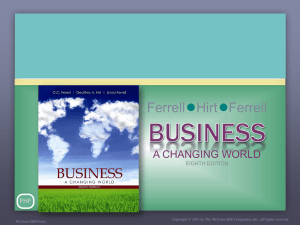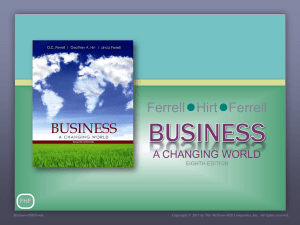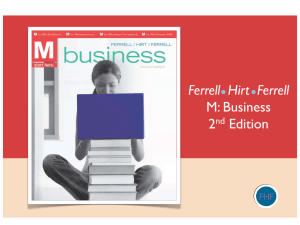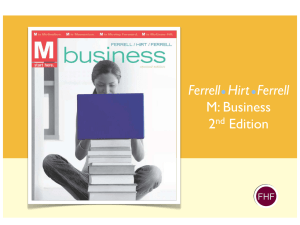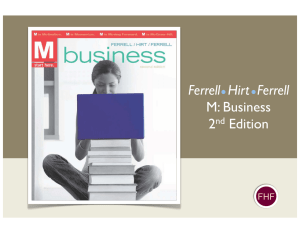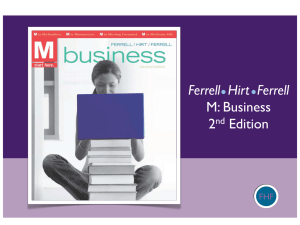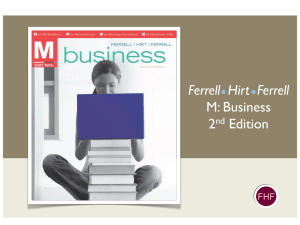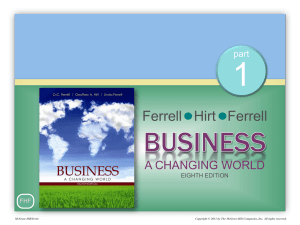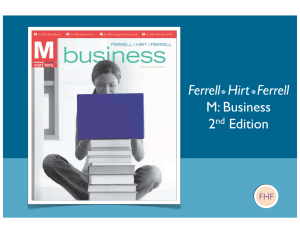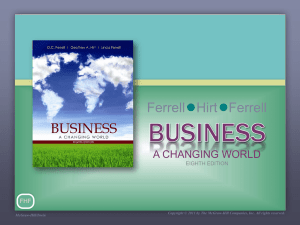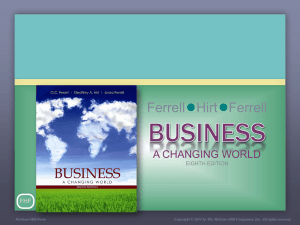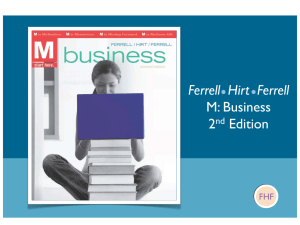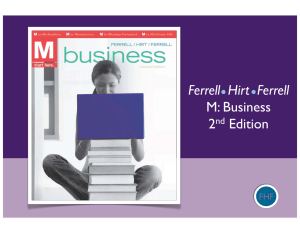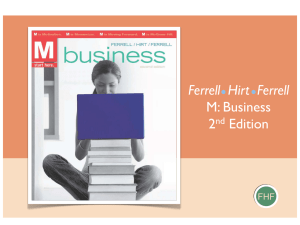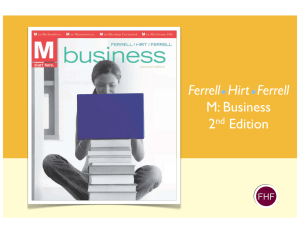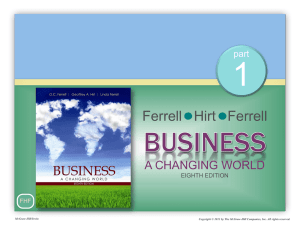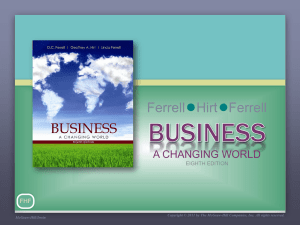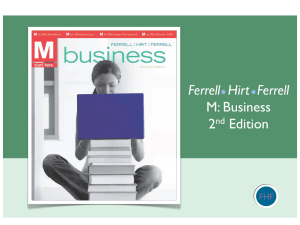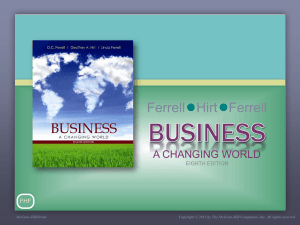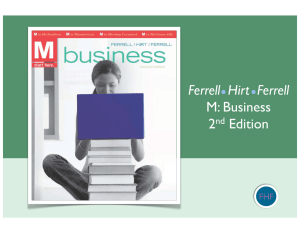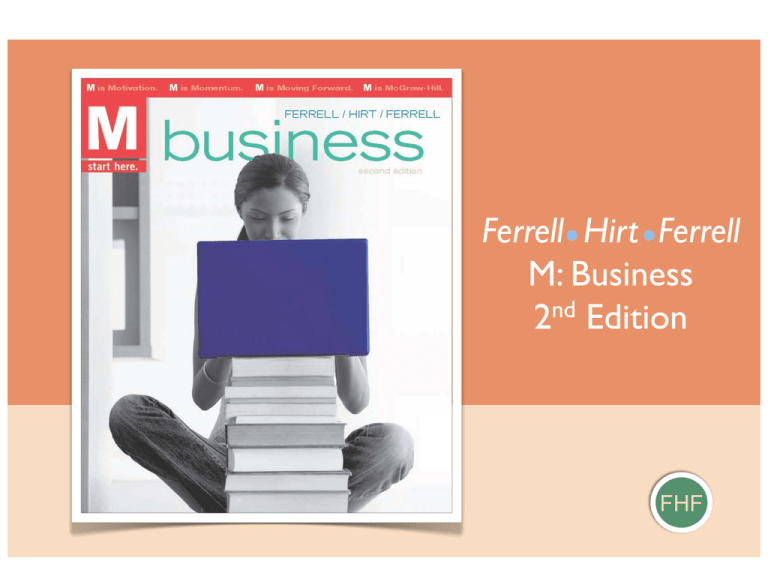
Ferrell Hirt Ferrell
M: Business
nd
2 Edition
FHF
Financial Management
and
Securities Markets
FHF
McGraw-Hill/Irwin
Copyright © 2011 by the McGraw-Hill Companies, Inc. All rights reserved.
Working Capital Market
The management of short-term assets and liabilities
• Current assets: short-term resources
✴ Cash
✴ Investments
✴ Accounts receivable
✴ Inventory
• Current liabilities: short-term debts
• Accounts payable
• Accrued salaries
• Accrued taxes
• Short-term bank loans
FHF
16-3
Transaction Balance
[
Cash kept on hand by a firm to pay normal
daily expenses such as employee wages and
bills for supplies utilities
]
FHF
16-4
Lockbox
[
An address, usually a commercial bank, at
which a company receives payments in
order to speed collections from customers
]
FHF
16-5
Investing Idle Cash
Marketable Securities
• Temporary investment of extra cash by
organizations up to one year in U.S. Treasury bills,
certificates of deposit, commercial paper, or
Eurodollars
Treasury B`ills
• Short-term debt obligations the U.S. government
sells to raise money.
FHF
16-6
Investing Idle Cash (continued)
Commercial Certificates of Deposit (CDs)
• Issued by commercial banks and brokerages available
in minimum amounts of $100,000 and can be traded
prior to maturity
Commercial Paper
• A written promise from one company to another to
pay a specific amount of money
Eurodollar Market
• A market for trading U.S. dollars in foreign countries
FHF
16-7
Short-Term Investment for Idle Cash
FHF
16-8
Accounts Receivable and Inventory
Occurs on the balance sheet after cash and marketable securities
Accounts Receivable
• Money owed to a business by credit customers
Optimizing Inventory
• Minimize firm’s investment in inventory without experiencing
production cutbacks
FHF
16-9
Managing Current Liabilities
Accounts Payable
• Money an organization owes to suppliers for goods
and services
Trade Credit
• The most important account payable
• Credit extended by suppliers for the purchase of
their goods and services
FHF
16-10
Bank Loans
Line of Credit
• An arrangement by which a bank agrees to lend a
specified amount of money to an organization upon
request
Secured Loans
• Loans backed by collateral that the bank can claim
if the borrowers do not repay the debt
FHF
16-11
Unsecured Loan
• Loans backed only by the borrower’s good
reputation and previous credit rating
Prime Rate
• The interest rate that commercial banks charge their
best customers for short-term loans
Bank Loans (continued)
FHF
16-12
Non-Bank Liabilities
Short-term loans from insurance companies, pension
funds, money market funds, or finance companies
Factoring organization
• Purchases accounts receivable at a discount
Taxes and employees’ wages
FHF
16-13
Long-Term (Fixed) Assets
• Expected to last for many years
• Production facilities (plants), offices, and equipment
• Tend to be high-cost, making financing critical
FHF
16-14
Capital Budgeting
• The process of analyzing the needs of business
and selecting the assets that will maximize its
value
• Not an exact process
• Managers must be flexible as new information
becomes available
FHF
16-15
Assessing Budgeting Risk
FHF
16-16
Long-Term Money
Factors to Consider:
• How much cash will be generated
• Cost of financing
• Supply of funds available for investment
• Accurately identifying opportunities with the
greatest potential for ROI
FHF
16-17
Financing with Long-Term Liabilities
Debts that will be repaid over a number of years
• Long-term loans
• Bond issues
FHF
16-18
Bonds
Are Corporate IOU’s
• Debt instruments that larger companies sell to raise
long-term funds
• Indenture:
✴ The bond contract specifying all terms of agreement
between bondholder and the issuing organization
FHF
16-19
Types of Bonds
Unsecured Bonds
• Debentures, or bonds, that are not backed by
specific collateral
Secured Bonds
• Bonds that are backed by specific collateral that
must be forfeited in the event the issuing firm
defaults
Serial Bonds
• A sequence of small bond issues of progressively
longer maturity
FHF
16-20
Floating-Rate
• Bonds with interest rates that change with current
interest rates otherwise available in the economy
Junk Bonds
• Special type of high interest rate bond that carries
higher inherent risks
Types of Bonds (continued)
FHF
16-21
A 30-Year Treasury Bond
FHF
16-22
Financing with Owner’s Equity
The owners’ investment in an organization
•Common Stock
• The most important source of capital for most new
companies
•Gives stockholders voting and control rights
FHF
16-23
Preferred Stock
• Gives the stockholder preference in distribution of
profits, but not voting and control rights
Retained Earnings
• Earnings after expenses and taxes that are reinvested
in the assets of the firm and belong to the owners in
the form of equity
Financing with Owner’s Equity
FHF
16-24
When a Company has Profits Left Over
After Paying Expenses and Taxes
Retained Earnings
• Reinvested in the assets of the firms
Dividend Yield
• The dividend per share divided by the stock price
✴ Not all companies pay dividends
FHF
16-25
Investment Banking
Is the sale of stocks and bonds for corporations
Primary Market
• New issue or initial public offering (IPO)
Secondary Market
• Stock exchanges and OTC markets where
investors trade securities with each other
FHF
16-26
Securities Market
The mechanism for buying and selling securities
The Stock Market
• NY Stock Exchange and NASDAQ now are for-profit businesses
• Most exchanges are or are becoming electronic– making organized
exchanges less centralized
Over-the-Counter Market (OTC)
• A network of dealers all over the country, and world, linked by
computers, telephones, and teletype machines
FHF
16-27
• American International Group was bailed out by
the government
✴ Other banks like Lehman Brothers were allowed to fail
• An insurance company run like a (risky) hedge
fund
• Danger of high-tech trading is that most people do
not know the risks
FHF
16-28
Measuring Market Performance
• Indexes
• Averages
• Bull market
• Bear market
FHF
16-29
Note: Data was taken from the mid-point of each month.
Source: "Market Overview," Yahoo Finance
FHF
The Dow Jones Industrial Average
16-30
FHF
16-31

